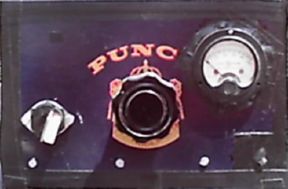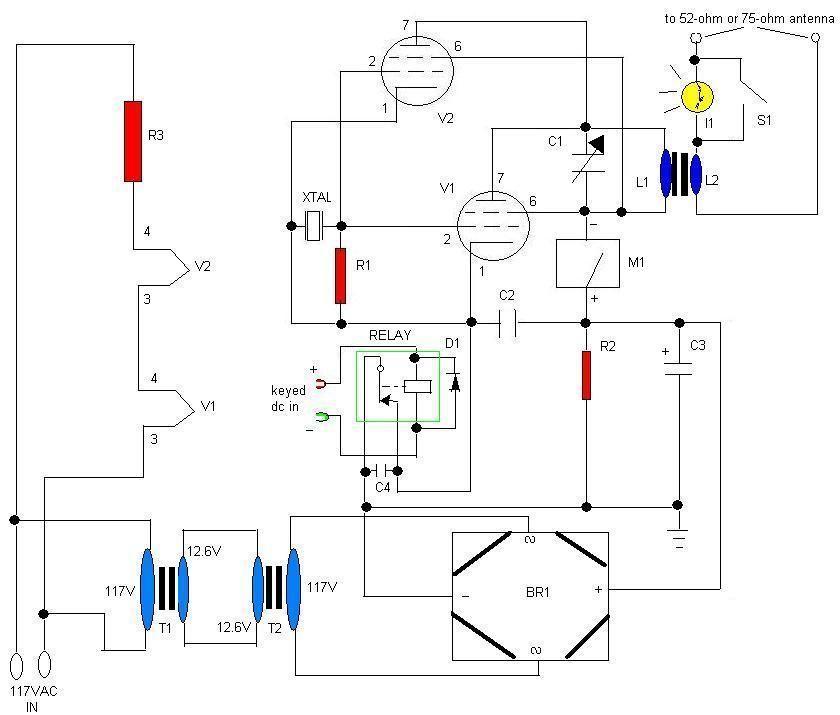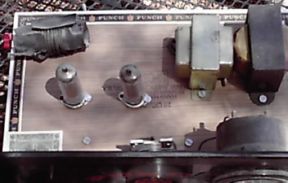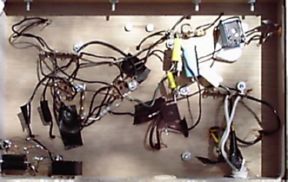amateur radio license required to operate
on the air!

6-WATT 2-TUBE CW TRANSMITTER FOR 40 METERS
Cost estimate: $60
Here we go beyond the QRP upper limit - but not by much - with an economical, relatively powerful
(six watts RF output) and dependable crystal-controlled transmitter
using tubes! It's fun to build, easy to operate, and very inexpensive considering
its performance. The original early 1990's design is modified by featuring either a meter
or a lamp - or both - for tuning, a power resistor instead of a more expensive
third tube for ballast in the filament circuit, and relay-keying for assured safety.
A cigar box provides the chassis and front panel, and all parts are readily available.
Design:
A glance at the schematic below reveals this is an oscillator using two tubes in
parallel to obtain the RF output. The tubes' filaments are powered directly from the AC
source. Two back-to-back common power transformers safely feed AC into a bridge rectifier. The
resultant DC ("B+") voltage is filtered and goes to the twin-tube oscillator. Since high voltage
(up to 160VDC) can be a hazard if a key is used directly, a
keying relay circuit is shown here.
Direct keying is of course fine, but if used it is recommended that
the key terminals are safely isolated from the operator's hand! The meter shown is optional,
as is the lamp; either scheme (or both) can be used to tune the transmitter.
 R1: 100K/1W resistor
R1: 100K/1W resistor
R2: 27K/2W resistor
R3: 100-ohm/5w power resistor
C1: 365pF variable capacitor
C2: .047uF/630v capacitor
C3: 22uF/350v electrolytic capicitor
C4: .01uF/500v capacitor
D1: 1N4004 rectifier diode
BR1: 1 AMP/250 PIV bridge rectifier
S1: SPST switch
L1: 15 turns hookup wire on a 7/8" form (wood dowel, plastic pill bottle, etc.)
L2: 7 turns of the same wire wound over L1
M1: 100ma panel meter
T1,T2: 117vac/12.6vac power transformers (center-tap models OK, center-taps not used)
V1,V2: 50C5 beam power amplifier tubes
RELAY: 12v SPST relay (a 9v relay could also be used)
I1 6-volt bulb (a #44 is perfect)
XTAL: Original manufacturer FT-243 or HC17/U fundamental frequency 40-meter band crystal
ALSO: two 7-pin miniature tube sockets, two jacks (for key-in and antenna out),
a crystal socket or holder, nuts and bolts, hookup wire, a socket for bulb I1,
two 4-lug terminal strips, a knob for C1, and an AC cord and plug.

 Construction:
All parts are available from most electronics supply houses, except the tubes, which are
from Antique Electronics Supply (other sources are certainly out there too). Use power
transformers rated at least 1 amp. Transformers with lower current ratings
may suffice, but erring on
the side of caution is a good idea with any tube project. The 50C5 tubes use 7-pin miniature sockets.
Attach the panel (cigarbox top) to the chassis (the upside-down box).
Drill the holes and create the openings for the chassis and panel components and mount them;
the major components "on top" of the chassis and the support wiring below.
Be sure to include tie points
for the subsequent wiring (two 4-lug terminal strips should do). Proceed with adding the
remaining components and wiring. The builder may choose to use either the lamp and/or the meter for
tuning. Both methods work well; the lamp-with-switch method has the advantages of less cost and ability
to decrease output power to just under 5 watts if desired.
It is recommended to finish by taping another cigarbox-top to the bottom for safety and convenience. Of course, other construction schemes can be used; the original Popular Electronics article's version had all components mounted on top of a wooden board with a front panel attached.
Construction:
All parts are available from most electronics supply houses, except the tubes, which are
from Antique Electronics Supply (other sources are certainly out there too). Use power
transformers rated at least 1 amp. Transformers with lower current ratings
may suffice, but erring on
the side of caution is a good idea with any tube project. The 50C5 tubes use 7-pin miniature sockets.
Attach the panel (cigarbox top) to the chassis (the upside-down box).
Drill the holes and create the openings for the chassis and panel components and mount them;
the major components "on top" of the chassis and the support wiring below.
Be sure to include tie points
for the subsequent wiring (two 4-lug terminal strips should do). Proceed with adding the
remaining components and wiring. The builder may choose to use either the lamp and/or the meter for
tuning. Both methods work well; the lamp-with-switch method has the advantages of less cost and ability
to decrease output power to just under 5 watts if desired.
It is recommended to finish by taping another cigarbox-top to the bottom for safety and convenience. Of course, other construction schemes can be used; the original Popular Electronics article's version had all components mounted on top of a wooden board with a front panel attached.
Operation: Attach an antenna such a as a half-wave Dipole or dummy load, insert a crystal, and depress the code key. The keyed input can be provided
with any DC source appropriate for the relay, with the key connected to the positive (+) line.
A keying switch can be
be used if desired; much better is to use a
Station Controller.
Rotate the variable capacitor for lowest meter reading with
cleanest tone and smooth keying (around 60-80ma] and/or greatest brilliance of lamp
with best tone and keying. If using a lamp, when it is switched "in",
it will light brightly when tuned and provide reduced
output by about a watt. If the lamp is switched "out" it will light dimly
when tuned, without sacrificing
output. With some not-so-steady crystals switching "in" the lamp seems to smooth the signal.
That's it! Different crystals may have better or worse
performance, and some "remanufactured" crystals that are perfectly fine for transistor QRP rigs may be
impossible to tune, but odds are this glowing wonder will thrill and delight.
Note: A homebrew Bare
Essentials Transmitter from 1968 for 80 or 40 meters using a single 50C5 tube and no transformers
has recently enjoyed renewed popularity. It can be built for well under $20, but it
requires a ground connection for safety and puts out less power than the one presented
here. If budget is a major issue, by all means investigate it - there are many happy users.
..need parts?...
Sources:
Transmitter:
POPULAR ELECTRONICS, August 1992, p.45
Relay:
QST, November 2003, pp.29-30 (modified)
***HOME***


 Construction:
All parts are available from most electronics supply houses, except the tubes, which are
from Antique Electronics Supply (other sources are certainly out there too). Use power
transformers rated at least 1 amp. Transformers with lower current ratings
may suffice, but erring on
the side of caution is a good idea with any tube project. The 50C5 tubes use 7-pin miniature sockets.
Attach the panel (cigarbox top) to the chassis (the upside-down box).
Drill the holes and create the openings for the chassis and panel components and mount them;
the major components "on top" of the chassis and the support wiring below.
Be sure to include tie points
for the subsequent wiring (two 4-lug terminal strips should do). Proceed with adding the
remaining components and wiring. The builder may choose to use either the lamp and/or the meter for
tuning. Both methods work well; the lamp-with-switch method has the advantages of less cost and ability
to decrease output power to just under 5 watts if desired.
It is recommended to finish by taping another cigarbox-top to the bottom for safety and convenience. Of course, other construction schemes can be used; the original Popular Electronics article's version had all components mounted on top of a wooden board with a front panel attached.
Construction:
All parts are available from most electronics supply houses, except the tubes, which are
from Antique Electronics Supply (other sources are certainly out there too). Use power
transformers rated at least 1 amp. Transformers with lower current ratings
may suffice, but erring on
the side of caution is a good idea with any tube project. The 50C5 tubes use 7-pin miniature sockets.
Attach the panel (cigarbox top) to the chassis (the upside-down box).
Drill the holes and create the openings for the chassis and panel components and mount them;
the major components "on top" of the chassis and the support wiring below.
Be sure to include tie points
for the subsequent wiring (two 4-lug terminal strips should do). Proceed with adding the
remaining components and wiring. The builder may choose to use either the lamp and/or the meter for
tuning. Both methods work well; the lamp-with-switch method has the advantages of less cost and ability
to decrease output power to just under 5 watts if desired.
It is recommended to finish by taping another cigarbox-top to the bottom for safety and convenience. Of course, other construction schemes can be used; the original Popular Electronics article's version had all components mounted on top of a wooden board with a front panel attached.